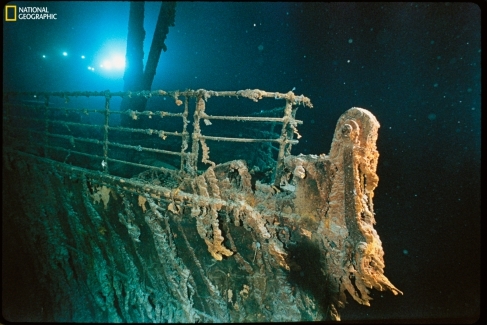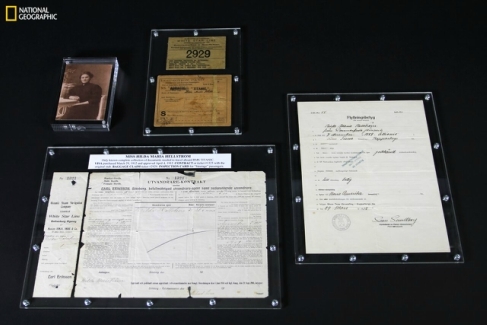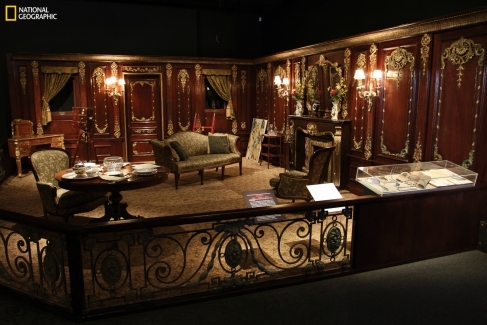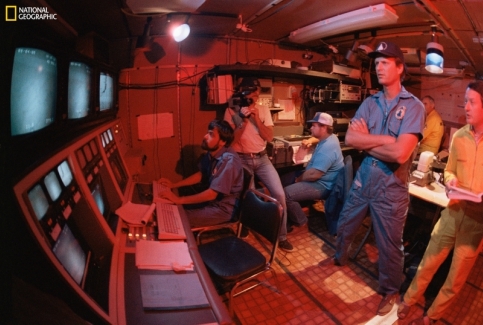National Geographic opens new Titanic-themed exhibit, highlighting the previously top-secret details behind its discovery.

The bow of the Titanic wreck (Photo courtesy of Emory Kristof and The National Geographic Society.)
National Geographic opened its newest exhibit, “Titanic: The Untold Story”, which features a behind-the-scenes look into the mysterious connections between a top-secret Cold War mission and the discovery of the Titanic in 1985. Throughout the exhibit, Robert Ballard, oceanographer and ship discoverer, shares his own unique experience, adding yet another dimension to the story that has fascinated scores of people for decades since the fateful night in 1912.
“I wasn’t supposed to find the Titanic,” Ballard said. “But when I mapped these two submarines I learned about the debris and I said, ‘let’s try something really crazy.’ I mean everyone thought it was absolutely nuts because no one had ever tried to do what I was trying to do.”

The only existing complete set of boarding documents from the RMS Titanic (Photo courtesy of The National Geographic Society.)
The exhibit features well-known artifacts from the ship, including a life vest worn by Madeleine Astor, Mabel Bennett’s coat and the only surviving set of boarding documents. The display also boasts pieces from James Cameron’s 1997 Titanic movie, including original costumes, the grand staircase clock and the Heart of the Ocean necklace. Guests interested in learning about the ship’s lesser-known history will enjoy the latter part of the exhibit, which shares the stories of crewmembers and passengers in each of the Titanic’s three classes.
“Most people didn’t know, and many still don’t know, that I have been living a double life for a long time,” Ballard said. “I would disappear, because oceanographers always disappear and go out on missions. And in most cases, mine were highly classified.”

Rose and Cal’s Suite from the 1997 Titanic film (Photo courtesy of The National Geographic Society.)
With a background in both the army and navy, as well as a graduate degree in oceanography, Ballard spent much of his early life submerged in the study of the ocean. In 1985, Ballard was sent on a naval mission to uncover the remnants of the USS Thresher and the USS Scorpion, two nuclear submarines that sunk in the North Atlantic during the Cold War.
“I was sent on a pretty major mission, “Ballard said. “But basically I cut a deal with the Navy because I wanted to find the Titanic.”
Ballard notes that the French were originally supposed to locate the ship’s remains. After their mission failed, Ballard was left with only 12 days and very limited resources to find it on his own. A combination of unconventional thinking, careful observation and luck led his team to the discovery of the ship’s boiler on the night of September 1, 1985.

Ballard and crew during his search for the Titanic in 1985 (Photo courtesy of Emory Kristof and The National Geographic Society.)
“We were down to four days and I still hadn’t found it,” Ballard said. “I had just changed the watches, and I had gone up to my room to sleep, but couldn’t — the cook came in and got me because everyone else was too excited to leave the command center.”
Ballard said he has enjoyed reliving the discovery through the creation of the exhibit, and is looking forward to seeing the public learn more about one of the most intriguing historic events of all time.
The exhibit opened May 30 and runs until January 2019 at the National Geographic Museum. The museum is open daily from 10 a.m. to 6 p.m. Adult tickets are $15. Seniors/Students/Military $12. Children 5-12 (free under 5) $10,




